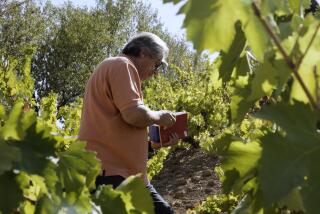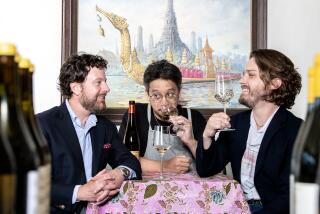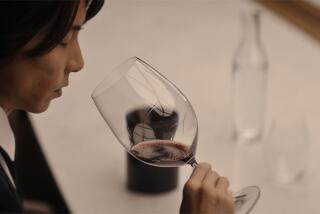South Africaâs Classic Sauvignon Blanc Country
When oceans collide off a warm land mass, a certain kind of climate happens. When the collision coincides with a coastal topography and latitude that are suitable for wine grapes, a certain kind of magic can happen too.
We can taste that phenomenon in the impressive 2001 Sauvignon Blancs now reaching our shores from South Africa. More than the very good but unremarkable Chardonnays and Cabernets that seem to be getting more attention at the moment, these Sauvignons are wines that say something about where theyâre from.
A perfect example is the Fleur de Cap âReserve.â A consummately sensual Sauvignon Blanc with fine weight and provocative texture, it pushes all the right buttons with a telescoping array of ripe varietal aromas and flavors that are not quite like any of the typical Sauvignons from other regions.
The best Sauvignon Blancs from the Cape--and there are more every vintage--strike a perfect note near the middle of the varietyâs flavor spectrum. Any one wine may show an impressive roster of classical Sauvignon Blanc impressions: the quivering intensity of Sancerre, the stony edge of Pouilly-Fume, the bright green aromas and flavors of New Zealand (although stopping on the safe side of that pungent scent so familiar to cat owners), the fine weight and body of Graves and the ripe melon flavors of Northern California.
In other words, when you smell New Zealand and taste Sancerre in a wine with Californian depth, welcome to South Africa.
The Dutch colonists who settled the Cape in the 17th century couldnât have imagined a wine like that. They saw the general viticultural potential right away, though. They planted vines on the slopes overlooking the sea, and one autumn day in 1659 acting governor Jan van Riebeeck wrote in his diary, âToday, praise be to God, wine was made for the first time from Cape grapes.â
Almost immediately, the Cape began competing with Bordeaux in the northern European wine market. Napoleon helped things out by cutting Bordeaux off from the English, who even back then bought huge volumes of wine. But by the 20th century, things were going terribly wrong.
Between world wars, global recessions and other nationsâ rejection of apartheid, South Africa lost its edge. California, Australia and Chile went thundering down the track while Afrikaners played catch-up with bulk wine and a few credible but unexciting bottled varietals.
Only since the lifting of anti-apartheid sanctions in 1994 (coinciding with a worldwide economic boom) has there been significant new capital to upgrade cellars and reestablish an export market. That has given a huge boost to the wine industryâs evolution.
The prevalent impression of Africa is searing heat, which is not a good thing for fine wine, but the wine regions fanning inland from the Cape of Good Hope defy that stereotype. Between the warm Indian Ocean and the cold Atlantic, the fine, dry heat of the continent is tempered and shaped into excellent growing conditions.
The Indian Ocean is a relatively balmy influence which creates the great sugar plantations of KwaZulu-Natal on South Africaâs southeast coast. The frigid Atlantic, subject to the fury of the Roaring Forties and winds blowing unchecked from Antarctica, is cold enough to make oyster farming a growth industry on South Africaâs northwest coast.
The complex marine-influenced climate is reflected and amplified by diverse exposures and well-drained granite soils, producing a multifaceted range of wines. Among all the worldâs wine regions, only Margaret River in southwestern Australia is similarly situated. Not surprisingly, the wines of the Cape are generally similar to those of Margaret River: nicely fragrant with crisp, intense fruit, well-defined flavor, bracing acidity and moderate alcohol.
In a broad sense they are more like European than Californian or Australian wines, but thereâs more to it than that. The Cape is a viticultural world of its own.
Sauvignon Blanc owns that world. It does not suffer fools in the vineyard or the winery. It laughs at less-than-meticulous viticulture and makes a dunce of any grower who, out of greed or ignorance, tries to over-crop. It also defeats new oak infusion, malolactic fermentation and other sledgehammer winemaking ploys routinely applied to Chardonnay. Sure, it can deliver intense, complex sensations--but they come more from the grape, and the environment in which it ripens, than from the winery.
And it ripens beautifully in the nooks and crannies of the Capeâs granite crags. No accident, then, that the current South African cult wine list includes several Sauvignons from the 2001 vintage. Among them is the Neil Ellis âGroenekloof (Green Gorge).â Itâs similar to the Fleur de Cap âReserve,â but more concentrated and intense. Thereâs that high fresh foliage matrix, but itâs not green in the sense of unripe--this is a wine from profoundly ripe grapes. The combination of ripeness and verve reflects the cold Atlantic influence in the seaside Darling area.
The Vergelegen, another South African cult Sauvignon, seems massive at first sip, yet it nimbly makes a surgical strike on the taste buds. Itâs voluminous, intense and racy, all high-toned gooseberry, green pepper and alpine meadow nose with a whiff of snow on rock before coating the palate with rich, clear, snappy fruit. The Mulderbosch is less complex but also herbaceous and breezy with spine-tingling acidity. But here, again, is a core of ripe fruit. The Neethlingshof is another good example, showing deeply concentrated flavors that sweep across the palate like a rainy wind heavy with the scent of tiny flowers and wet stone.
Then thereâs a trio of 2001 Sauvignons from Durbanville Hills, a grower-owned winery that puts technological sophistication at the service of terroir-expressive winemaking. These wines offer a rare declension of increasingly expressive wines from an outstanding Sauvignon Blanc district.
The basic Durbanville Hills is a definitive Cape Sauvignon, bracing and delicate with focused mountain-spring flavors. The âRhinofieldsâ bottling, a vineyard selection, goes to a deeper level of intensity, at once more concentrated and finer, its bright herbaceous tones accenting richer tropical fruit. That wine shows a distinct flavor of granite dust that is further amplified in the âBjesjes Craal,â a single-vineyard bottling from the heart of the Durbanville climate. The dustiness draws a faint, fine line through the concentrated scents and flavors of fruit and tender grasses, reconciling all opposing values in a wine that says, âI came from a vineyard on the Cape of Good Hope.â
Recently a few showy South African Chardonnays have gotten a lot of attention by prevailing in publicity-driven judgings. Itâs important to remember that those wines were made to excel in that setting. A typical wine judging is a kind of sensory weightlifting contest, in which size matters beyond reason and subtlety is lost in orgies of oak, extract and alcohol. Wine producers the world over are schooled in techniques that produce contest-winning wines. Unfortunately, beyond a handful of showcase bottlings, most South African Chardonnays resemble their Californian and Australian counterparts from the 1980s.
That wonât always be the case; things are happening fast on the Cape. But for now, South Africa has found its viticultural voice in Sauvignon Blanc.
*
Smith is writer-at-large for Wine & Spirits Magazine.
More to Read
Eat your way across L.A.
Get our weekly Tasting Notes newsletter for reviews, news and more.
You may occasionally receive promotional content from the Los Angeles Times.










